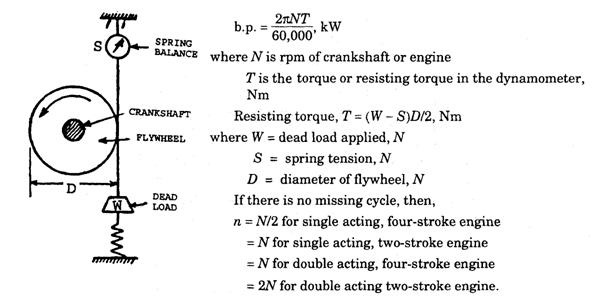4.2.
Power and M.E.P
(a) Indicated Power (i.p.) is the net power actually developed at the piston face during
the events of mechanical cycle. It is so named because it is determined by the use of an
instrument called an ‘engine indicator’. It can be expressed as,
![clip_image002[16] clip_image002[16]](http://lh6.ggpht.com/_Ii1ukGkfijY/SqqZEvGdEoI/AAAAAAAADrE/66D9HMOdF-4/clip_image00216_thumb.gif?imgmax=800) |
where, I is length of stroke, m
A is cross-sectional area of cylinder, m2
n is number of power impulses/min or number of working strokes/min
pi is indicated mean effective pressure (i.m. e.p.), Pa.
(b) Indicated Mean Effective Pressure (i.m.e.p. or simply i.m.p.) is the algebraic sum
of the mean pressures acting on the piston during each stroke over one complete cycle. The
pressures are positive when acting in the direction of the piston movement and negative when
opposite to the direction of movement of piston. It is measured through indicator diagram drawn
with the help of an engine indicator. Thus,
(c) Brake Power (b.p.) is the actual work output of an engine or the actual work available
at the crankshaft and is termed so because it can be obtained by absorbing (also by transmission
dynamometer) the power output by means of some form of brake. This is also termed shaft
power (s.p.).
 |
Figure 4.1 illustrates the principle of rope-brake absorption type dynamometer. The b.p.
can be expressed as,
Fig. 4.1. Schematic of rope-brake
dynamometer.
The engines cannot be compared on the basis of their
relative powers as power depends not only on size but also on speed.
(d) Brake Mean Effective Pressure (b.m.e.p.) is the m.e.p., which could have developed
power equivalent to the b.p. calculated above if ncted on the piston. It is a comparative measure
of the power capabilities of engines, which operate with the same engine displacement and
speed, and forms a basis for the index of performance.
The b.m.e.p. unlike i.m.e.p. cannot be measured directly. Both b.m.e.p. and i.m.e.p of a petrol
engine increase with the compression ratio up to the limit of compression fixed by the detonating
properties of the fuel used.
(e) Friction Power (f.p.) of an engine is less than its i.p. owing to frictional losses at the
working surfaces like bearings, piston rings and valves. The power lost in this way is known as
friction power. Thus,
The i.p. of an engine can be determined by adding the f.p. to its b.p. This method is suitable
for high power engines where the f.p. is comparatively high and the measurement of i.p. by
engine indicator is not possible. The f.p. of the engine is obtained by motoring it by use of an
electric dynamometer operating as a motor. The f.p., thus, obtained includes both mechanical
friction and fluid friction (pumping losses of the exhaust and intake processes).
![clip_image006[20] clip_image006[20]](http://lh4.ggpht.com/_Ii1ukGkfijY/SqqZQRZA2yI/AAAAAAAADrs/-4cwIrlod_o/clip_image00620_thumb.jpg?imgmax=800) |
(/) Engine Torque. The torque and the b.m.e.p. of a given engine are linearly related. Since,
Therefore,
where,
Thus, when brake torque and b.m.e.p. are plotted against rpm., the shapes of the resulting
curves should be similar. This is not a good index of performance as it depends on the size of
the engine. But for automobile engines, the torque is significant from driving viewpoint.
(g) Piston Speed. The piston speed of an engine is the total travel made by a piston in one
minute, i.e. piston =2 N x stroke, for double acting two-stroke engine.
